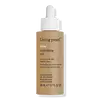What's inside
What's inside
 Key Ingredients
Key Ingredients

 Benefits
Benefits

 Concerns
Concerns

 Ingredients Side-by-side
Ingredients Side-by-side

Cyclopentasiloxane
EmollientDimethiconol
EmollientCaprylyl Methicone
Skin ConditioningPhenyl Trimethicone
Skin ConditioningArgania Spinosa Kernel Oil
EmollientOryza Sativa Bran Oil
EmollientBambusa Vulgaris Extract
Skin ConditioningHydrolyzed Soy Protein
HumectantMoringa Oleifera Seed Oil
EmollientGlyceryl Linoleate
EmollientTocopherol
AntioxidantWater
Skin ConditioningGlycerin
HumectantParfum
MaskingPolysilicone-15
UV FilterGlyceryl Linolenate
EmollientPotassium Sorbate
PreservativeDimethicone Crosspolymer
Emulsion StabilisingPhenoxyethanol
PreservativeBenzyl Salicylate
PerfumingCitronellol
PerfumingGeraniol
PerfumingHydroxycitronellal
PerfumingButylphenyl Methylpropional
PerfumingLimonene
PerfumingLinalool
PerfumingHydroxyisohexyl 3-Cyclohexene Carboxaldehyde
MaskingAlpha-Isomethyl Ionone
PerfumingCyclopentasiloxane, Dimethiconol, Caprylyl Methicone, Phenyl Trimethicone, Argania Spinosa Kernel Oil, Oryza Sativa Bran Oil, Bambusa Vulgaris Extract, Hydrolyzed Soy Protein, Moringa Oleifera Seed Oil, Glyceryl Linoleate, Tocopherol, Water, Glycerin, Parfum, Polysilicone-15, Glyceryl Linolenate, Potassium Sorbate, Dimethicone Crosspolymer, Phenoxyethanol, Benzyl Salicylate, Citronellol, Geraniol, Hydroxycitronellal, Butylphenyl Methylpropional, Limonene, Linalool, Hydroxyisohexyl 3-Cyclohexene Carboxaldehyde, Alpha-Isomethyl Ionone
C13-15 Alkane
SolventIsohexadecane
EmollientIsododecane
EmollientIsoamyl Laurate
EmollientEthylene/Propylene/Styrene Copolymer
C9-12 Alkane
SolventHippophae Rhamnoides Fruit Oil
Skin ProtectingHelianthus Annuus Seed Oil
EmollientCoco-Caprylate/Caprate
EmollientBrassica Campestris/Aleurites Fordi Oil Copolymer
Skin ConditioningCitrullus Lanatus Seed Oil
EmollientMoringa Oleifera Seed Oil
EmollientSimmondsia Chinensis Seed Oil
EmollientOrbignya Oleifera Seed Oil
EmollientPhytosteryl/Octyldodecyl Lauroyl Glutamate
Skin ConditioningButylene/Ethylene/Styrene Copolymer
Amaranthus Caudatus Seed Extract
Skin ConditioningDiisostearyl Malate
EmollientParfum
MaskingCitronellol
PerfumingLimonene
PerfumingCitral
PerfumingLinalool
PerfumingPentaerythrityl Tetra-Di-T-Butyl Hydroxyhydrocinnamate
AntioxidantC13-15 Alkane, Isohexadecane, Isododecane, Isoamyl Laurate, Ethylene/Propylene/Styrene Copolymer, C9-12 Alkane, Hippophae Rhamnoides Fruit Oil, Helianthus Annuus Seed Oil, Coco-Caprylate/Caprate, Brassica Campestris/Aleurites Fordi Oil Copolymer, Citrullus Lanatus Seed Oil, Moringa Oleifera Seed Oil, Simmondsia Chinensis Seed Oil, Orbignya Oleifera Seed Oil, Phytosteryl/Octyldodecyl Lauroyl Glutamate, Butylene/Ethylene/Styrene Copolymer, Amaranthus Caudatus Seed Extract, Diisostearyl Malate, Parfum, Citronellol, Limonene, Citral, Linalool, Pentaerythrityl Tetra-Di-T-Butyl Hydroxyhydrocinnamate
 Reviews
Reviews

Ingredients Explained
These ingredients are found in both products.
Ingredients higher up in an ingredient list are typically present in a larger amount.
Citronellol is used to add fragrance/parfum to a product. It is often derived from plants such as roses. In fact, it can be found in many essential oils including geranium, lavender, neroli, and more. The scent of Citronellol is often described as "fresh, grassy, and citrus-like".
Since the Citronellol molecule is already unstable, Citronellol becomes irritating on the skin when exposed to air.
Citronellol is a modified terpene. Terpenes are unsaturated hydrocarbons found in plants. They make up the primary part of essential oils.
Citronellol is not able to be absorbed into deeper layers of the skin. It has low permeability,
Citronellol is also a natural insect repellent.
Learn more about CitronellolLimonene is a fragrance that adds scent and taste to a formulation.
It's found in the peel oil of citrus fruits and other plants such as lavender and eucalyptus. The scent of limonene is generally described as "sweet citrus".
Limonene acts as an antioxidant, meaning it helps neutralize free radicals.
When exposed to air, oxidized limonene may sensitize the skin. Because of this, limonene is often avoided by people with sensitive skin.
The term 'fragrance' is not regulated in many countries. In many cases, it is up to the brand to define this term. For instance, many brands choose to label themselves as "fragrance-free" because they are not using synthetic fragrances. However, their products may still contain ingredients such as essential oils that are considered a fragrance.
Learn more about LimoneneLinalool is a fragrance and helps add scent to products. It's derived from common plants such as cinnamon, mint, citrus, and lavender.
Like Limonene, this ingredient oxidizes when exposed to air. Oxidized linalool can cause allergies and skin sensitivity.
This ingredient has a scent that is floral, spicy tropical, and citrus-like.
Learn more about LinaloolMoringa Oleifera Seed Oil is the oil expressed from the seeds of Moringa oleifera plant. It is more commonly known as Moringa seed oil.
Moringa seeds have antioxidant, anti-inflammatory, and skin hydrating properties. These seeds are rich in oils, proteins, monounsaturated fats, and tocopherols.
As an emollient, moringa seed oil helps trap moisture in the skin by creating a film on top. This helps keep your skin hydrated and soft.
Many compounds in moringa seed oil are antioxidant and anti-inflammatory. These compounds include Vitamin E. , catechins, ferulic acid, and more.
Another compound found in Moringa seed oil is oleic acid.
Moringa trees are native to the Himalayan mountains.
This ingredient may not be fungal-acne safe.
Learn more about Moringa Oleifera Seed OilParfum is a catch-all term for an ingredient or more that is used to give a scent to products.
Also called "fragrance", this ingredient can be a blend of hundreds of chemicals or plant oils. This means every product with "fragrance" or "parfum" in the ingredients list is a different mixture.
For instance, Habanolide is a proprietary trade name for a specific aroma chemical. When used as a fragrance ingredient in cosmetics, most aroma chemicals fall under the broad labeling category of “FRAGRANCE” or “PARFUM” according to EU and US regulations.
The term 'parfum' or 'fragrance' is not regulated in many countries. In many cases, it is up to the brand to define this term.
For instance, many brands choose to label themselves as "fragrance-free" because they are not using synthetic fragrances. However, their products may still contain ingredients such as essential oils that are considered a fragrance by INCI standards.
One example is Calendula flower extract. Calendula is an essential oil that still imparts a scent or 'fragrance'.
Depending on the blend, the ingredients in the mixture can cause allergies and sensitivities on the skin. Some ingredients that are known EU allergens include linalool and citronellol.
Parfum can also be used to mask or cover an unpleasant scent.
The bottom line is: not all fragrances/parfum/ingredients are created equally. If you are worried about fragrances, we recommend taking a closer look at an ingredient. And of course, we always recommend speaking with a professional.
Learn more about Parfum